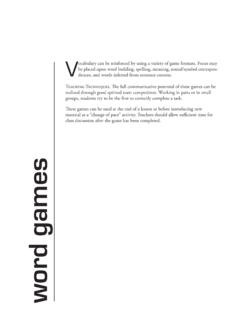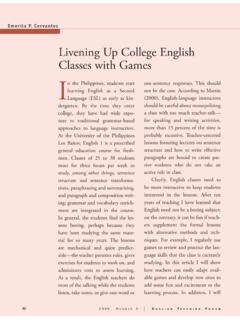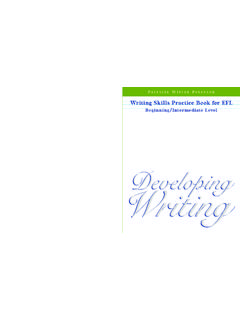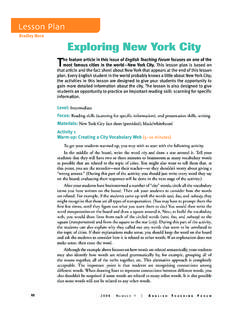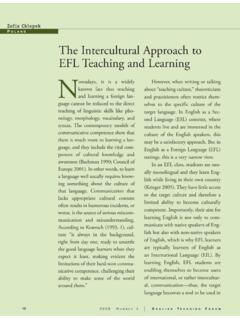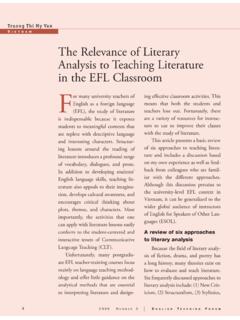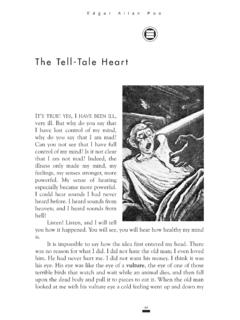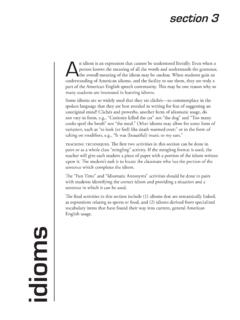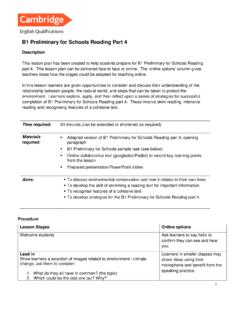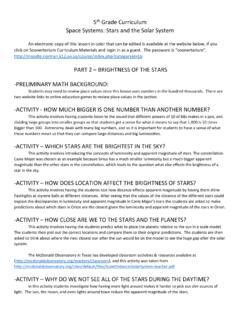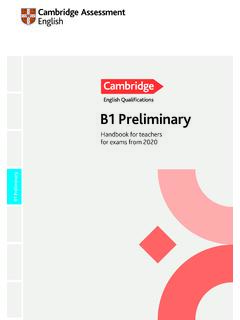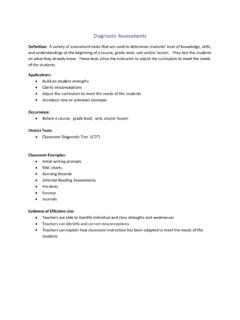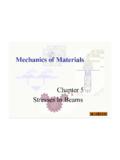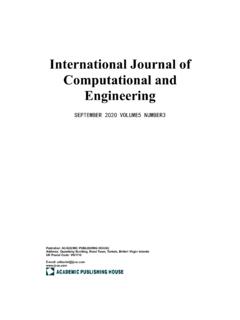Transcription of Good Instruction-Giving in the Second-Language Classroom ...
1 2017 ENGLISH TEACHING SOWELLCote d IvoireGood Instruction-Giving in the Second-Language ClassroomImagine you are attending a seminar. The facilitator gives instructions, and you have a vague notion of what you are supposed to do, but you do not want to ask the facilitator to clarify because you are sure you are the only one who has not understood. After the facilitator tells you to start working, you turn to the person next to you and ask, What are we supposed to do? That person says, I m not sure. I thought you would know. Soon you realize that almost everyone in the room is confused, while the facilitator is standing behind the lectern wondering why no one has started engaging in the activity she just explained. Most of us can recall an experience where the facilitator delivered instructions, but we were unclear about what we were expected to do.
2 And, as teachers, most of us have had experiences of giving instructions that were misunderstood or incomprehensible to our learners. While occasional foibles in giving instructions are understandable, mastering Instruction-Giving is a fundamental aspect of good Classroom teaching practice. Instructions and their delivery can be the determining factors as to whether a lesson succeeds or fails (Scrivener 2011; Ur 1996). According to Ur (1996, 16), research indicates that learners see the ability to explain things well as one of the most important qualities of a good teacher. For example, Wragg and Wood s (1984, 82) research found that the teacher s ability to explain is most highly valued. This article will investigate the importance and rationale for giving clear instructions in the Second-Language Classroom and provide techniques for giving effective instructions.
3 THE IMPORTANCE OF Instruction-Giving Instruction-Giving has a direct effect on learning; a lesson or activity becomes chaotic and fails when students do not understand what they are supposed to do. Nonetheless, good Instruction-Giving is a challenge for both native and nonnative language teachers, as well as for both seasoned and novice teachers. However, Instruction-Giving is a skill that is sometimes neglected for preservice and in-service teachers in teacher-training programs. New teachers might assume that it is a skill that will be naturally mastered; more experienced teachers might assume that it is a skill they have already mastered. For all language teachers, however, Instruction-Giving is an area that deserves attention and practice, as it has a major impact on how well students 2017 ENGLISH TEACHING able to carry out activities and, as a result, how well they learn.
4 GIVING INSTRUCTIONS IN THE MOTHER TONGUE Opinions differ as to whether Instruction-Giving is a permissible use of the first language (L1) in the Second-Language (L2) Classroom . Atkinson (1987), Auerbach (1993), and Macaro (1997) agree that Instruction-Giving is an occasion that warrants use of the L1 in the L2 Classroom . Both Ur (1996) and Cook (2016) believe that some use of the mother tongue might be necessary. Salaberri (1995) and Gardner and Gardner (2000) assert that students should be introduced to the use of English from the first class; doing so helps students understand that foreign languages are not just subjects to be studied but are also, and more importantly, a means of communication. Therefore, teachers should strive to incorporate the L2 needed for Instruction-Giving right from the beginning of a course (Salaberri 1995).
5 Of course, any use of the students native language is possible only if the instructor has some familiarity with it. In multilingual classes, it is an unrealistic expectation for the instructor to manage explanations in multiple languages. By extension, if teachers who do not speak their students native language(s) can make their instructions understood in English, it is possible for teachers who speak their students L1 to make themselves understood in English as might be instances when the use of the L1 for Instruction-Giving is justified for the sake of efficiency and clarity, but there is a danger of overuse and the possibility that students and teachers will become accustomed to the comfort of instructions in the L1. In my own experience in South Korea with students who had already studied English for many years, I found that quite a few of them had difficulty understanding simple instructions in English.
6 I surmise that this difficulty arose because of former experiences with receiving instructions in their L1. While use of the native language to give instructions might be helpful for beginning-level students, if continued for too long, it becomes a handicap rather than a help. USING TOTAL PHYSICAL RESPONSE TO GIVE COMMON INSTRUCTIONSOne of the preliminary activities I did with my Korean students at the beginning of each semester was based on Total Physical Response (TPR), a method of language teaching where the teacher gives a command and the students perform the action (Asher 2009). I first gave students a handout with a list of common instructional commands used throughout the course, such as Take out a pen or pencil and Turn to page ___ (see Table 1 for a list 1.)
7 Take out a pen or Take out a piece of paper. 3. Write your name on the paper. 4. Open your books. 5. Turn to page Read page _____. 7. Close your Put your books Stand up. 10. Sit down. 11. Find a partner. Put your desks Get into a group of _____ students. Put your desks Make a half-circle with the Look at the board. 15. Look at the teacher. 16. Look at the dialogue. 17. Repeat after me. 18. Raise your hand. 19. Put your hand Pass your papers to the 1. Common Classroom instructions in English2017 ENGLISH TEACHING common instructional commands). After demonstrating the actions and going over the list with students, I gave commands and had the students perform them. In my experience, starting the course with TPR for common instructions helps students understand typical Classroom language, which has a positive impact on Classroom initial TPR activities lay a foundation for Classroom instructions and Classroom language, they do not need to be restricted to the beginning of a course.
8 Teachers can add pertinent mini TPR lessons for instructions (and related Classroom language) as the course progresses. TPR lessons for instructions can relate to different aspects of the class, such as Instructions to Set up Class Work and Instructions to Bring the Class to an End (Gardner and Gardner 2000; Salaberri 1995), or they can be created based on student needs. Of course, TPR activities should match students proficiency levels. It is also important not to overwhelm learners with too many instructions in English at once (Gardner and Gardner 2000). For native and nonnative teachers who need guidance on giving instructions in English as well as other Classroom language, Hughes (1981), Gardner and Gardner (2000), and Salaberri (1995) are valuable resources.
9 Additional online resources for Classroom language teaching and learning include the following: worksheets/school/classroom_language/ are descriptions of the three stages for giving good instructions: the preparation stage, the delivery stage, and the post-delivery PREPARATION STAGE Good Instruction-Giving begins in the preparation stage. Although teachers may feel they can easily improvise, instructions are often not as clear to their students as they are to themselves (Ur 1996, 16). A good way to make sure your instructions for an activity are clear and concise is to write them out as you develop your lesson plan (Woodberry and Aldrich 2000). Scrivener (2011) suggests sticking with words that are familiar to your students, trying to write one sentence for each main point, and if your instructions seem too long deleting as many words as possible while still keeping the original meaning.
10 Of course, there will be some Wordy InstructionsConcise Instructions1. Now, I would like for you to get out a piece of paper and put it on your desk. 2. Once the paper is on the desk, could you please write down five questions using the present continuous tense?3. Now that you have written five questions, I would like for you to fold the paper in half. 4. Now, when I turn on the music, please pass your paper to the person on the left, and I would like for you to continue passing your papers until the music stops. 1. Take out a piece of paper. 2. Write down five questions using the present continuous tense. 3. Fold your paper in half. 4. When the music starts, pass your papers to the left. Continue passing your papers until the music stops.
